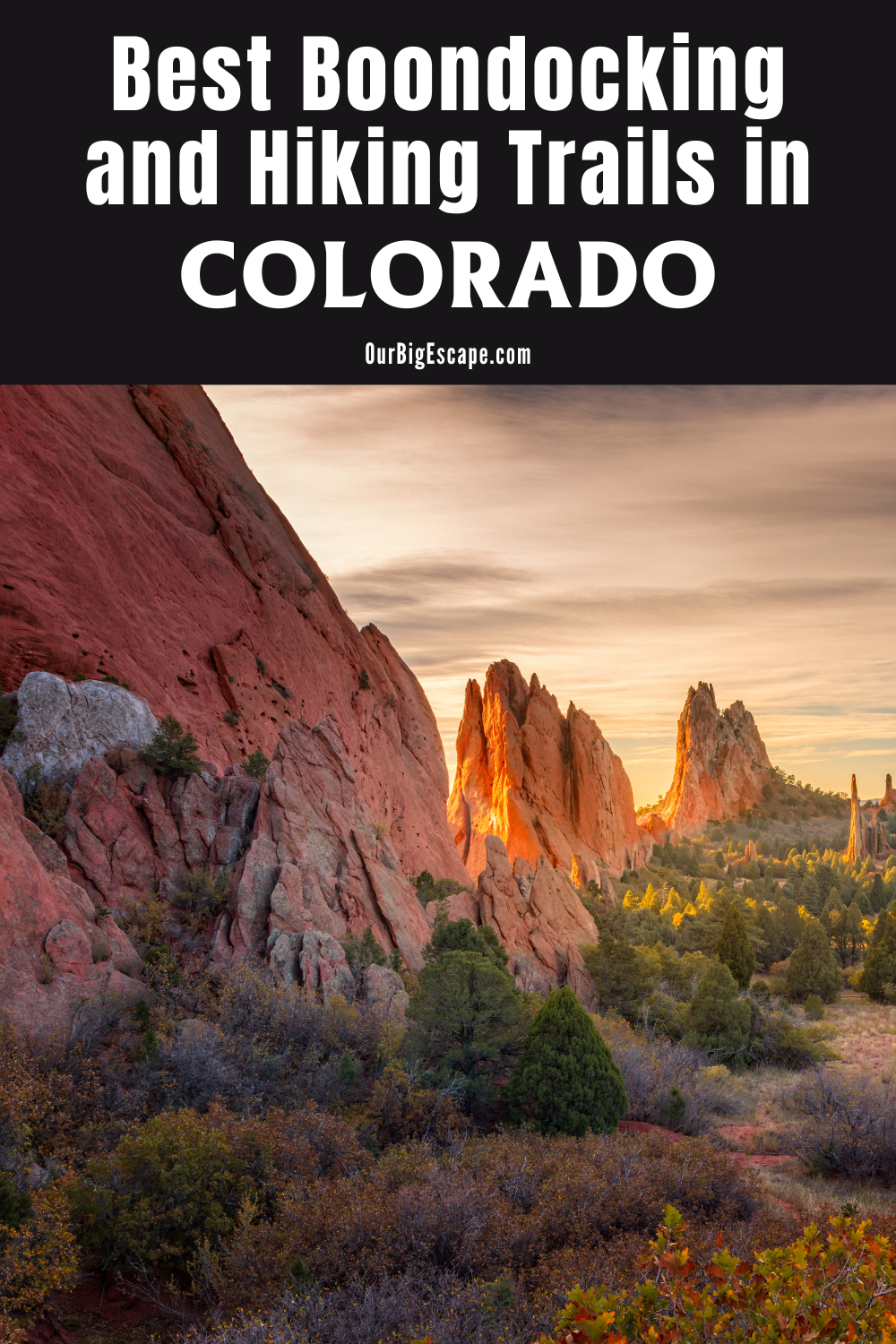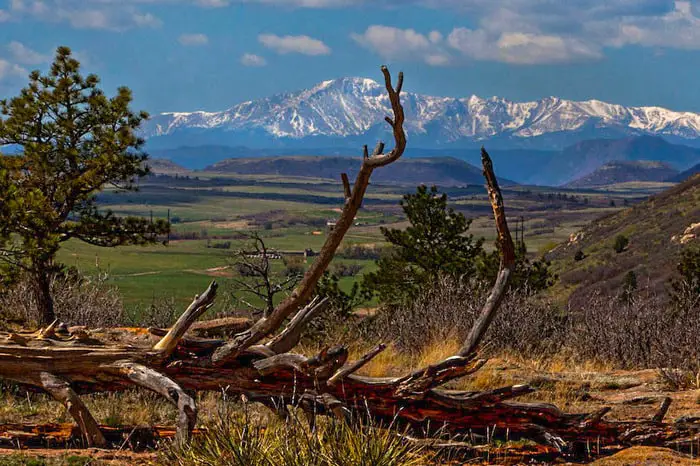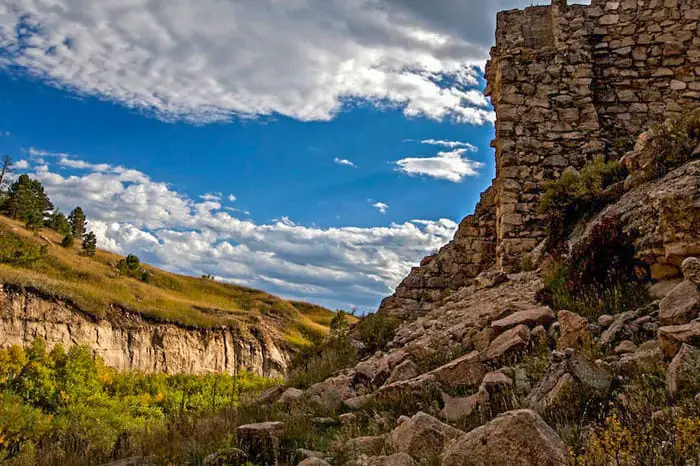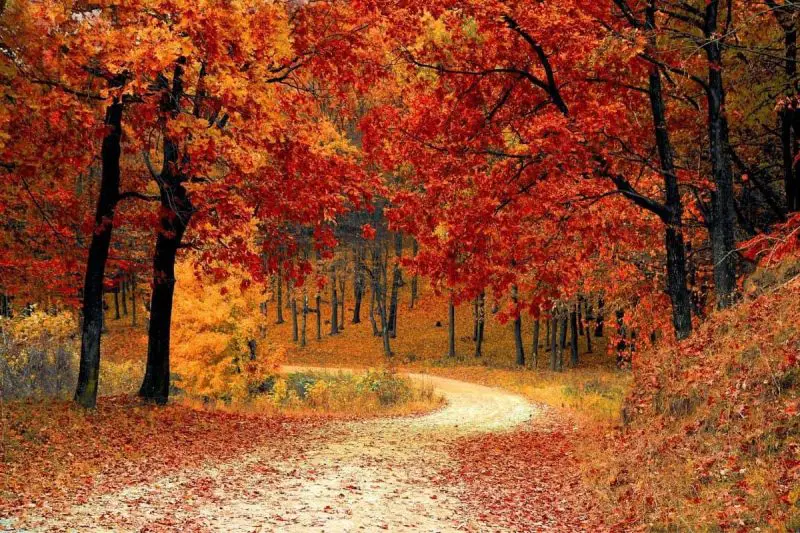We have located 9 great Castlewood Canyon State Park boondocking sites near the park because, as a day-use park, there is no overnight camping. Current park hours are from Sunrise to Sunset. A Colorado state park close to Franktown is called Castlewood Canyon State Park. The park safeguards a distinctive chapter in Colorado’s history (the Castlewood Canyon Dam).
On a number of mild to moderately difficult hiking trails, nature enthusiasts and groups can experience a variety of environmental settings. The trails can be connected for longer treks; they range in length from.5 to 4 miles. Wonderful rest places can be found along Cherry Creek’s twisting path as it flows along the canyon floor. Pets are permitted on most trails with a leash, with the exception of the brand-new East Canyon Preservation Area path.
Want more ideas to round-out your trip to Colorado?
A lot of great ideas are in these posts!
- 14 Great Sand Dunes National Park Boondocking (Updated 2022)
- 16 Browns Canyon Monument Boondocking (Updated 2022)
- 16 Colorado National Monument Boondocking (Updated 2022)
- 23 Canyon of the Ancients Boondocking (Updated 2022)
- 17 Black Canyon of the Gunnison Boondocking (Updated 2022)
- 110 Top Rocky Mountain National Park Boondocking (Updated 2022)
- 16 Hovenweep Monument Boondocking (Updated 2022)
- Best Rocky Mountain National Park Campgrounds 2022
- 9 Great Castlewood Canyon State Park Boondocking Sites
- 351 Free Colorado Boondocking Locations Along With Maps
- The 15 Best Rocky Mountain National Park Trails 1,2 or 3 Miles
Unique locations for weddings or other outdoor ceremonies include the natural amphitheater and the Bridge Canyon Overlook gazebo perched on the rim of the canyon. Picnic spots are available at both gates for informal gatherings and families. When the then-Castlewood Dam burst in 1933, sending a 15-foot-high wave of water into Denver, remnants of geologic history and local history came together. Hikers can still see the ancient homestead and the original ill-fated dam’s ruins.

9 Great Castlewood Canyon State Park Camping Spots
check out our video
1. Castlewood Canyon State Park Boondocking – South Rampart Range #29
Sedalia, Colorado
GPS: 39.316685, -105.086622
Elevation: 8287′
Forest Service
The road in is Dirt and 7 miles from a paved road. South Rampart Range #29 is open May 12-Oct. There are 30 or more Castlewood Canyon State Park Boondocking Sites at this location and the maximum RV length is 25 feet. You may stay 14 days-enforced at South Rampart Range #29.
2. Castlewood Canyon State Park Boondocking Sites – Wigwam Trailhead
Pine, Colorado
GPS: 39.2461, -105.35403
Elevation: 8166′
Public
The road in is Dirt and 8.5 miles from a paved road. There are 6-15 Castlewood Canyon State Park Camping Spots at this location. Various dispersed campsites on the dirt road to the Wigwam Trailhead in the Lost Creek Wilderness Aread. No toilets, no steady water, although there’s a stream a few hundred yards from some of the spots if you can traverse some of the areas. 100% pack-in, pack-out.
3. Castlewood Canyon State Park Camping Spots – Rainbow Falls
Rainbow Falls Road
Sedalia, Colorado
GPS: 39.15634, -105.11411
Elevation: 7497′
Forest Service (USDA)
The road in is Dirt and 1 miles from a paved road. Rainbow Falls is open year round. There are 16-29 Castlewood Canyon State Park Boondocking Sites at this location. You may stay 14 days at Rainbow Falls. Public forest service land just a few miles north of Woodland Park Colorado just inside the Douglas county line. A good number of pull offs available most of the year as the area is a bit remote and not well known. There are primitive restrooms in the parking lot at the entrance, but they are the only facilities.
4. Castlewood Canyon State Park Boondocking – New Growth
Woodland Park, Colorado
GPS: 39.096284, -105.135251
Elevation: 8507′
Forest Service
You may stay 14 days at New growth. Amazing spot! All very easy and large to pull into. (16 foot-long Trailer) Gorgeous sunsets. About 40 Castlewood Canyon State Park Camping Spots, but the first 10 have the easiest part of the road. We absolutely loved this spot. Not too far from town either. We did not have great service even tho it shows full bars on the reviews.
5. Castlewood Canyon State Park Boondocking Sites – Rampart Road Forest Land
Woodland Park, Colorado
GPS: 39.06272, -105.02426
Elevation: 9255′
Forest Service
Lots of dirt pull-offs along these roads in the National Forest. Quiet road. Several free Castlewood Canyon State Park Camping Spots around also. Great, easy to find, driving a small SUV and had one of the little pull offs. Had a fire ring nothing else but close access to Colorado Springs, Garden of the Gods, and Pikes Peak. Not big rig friendly.
6. Castlewood Canyon State Park Camping Spots – Off of Rampart Road
Cascade-Chipita Park, Colorado
GPS: 39.049102, -105.025613
Elevation: 9291′
State Forest
The road in is 4×4. There are 1-5 Castlewood Canyon State Park Boondocking campsites at this location. Should probably have 4 wheel drive to get to it because of the ruts on the trail/road to get to it. Nice tree coverage, but the campsite was nice and open. Couldn’t see Pikes Peak from where we were, but back towards the entrance there is a spot to see it and you can camp there too. There are probably 3 or 4 Castlewood Canyon State Park Boondocking places to camp off this trail/road.
Amenities
Fire Ring
Pets Welcome
7. Castlewood Canyon State Park Boondocking – Manchester Creek Road
Divide, Colorado
GPS: 39.0027, -105.1641
Elevation: 9101′
Forest Service
The road in is Dirt and .5 miles from a paved road. Manchester Creek Road is open Unknown. There are 6-15 Castlewood Canyon State Park Camping Spots at this location and the maximum RV length is unlimited. You may stay 14 at Manchester Creek Road. Access was good. About ¼ mile after it turns to dirt, there is a parking lot on the left for the ATVers to park and unload. There are pit toilets there. Some of the land became private but everything was clearly marked. I would say overall there is room for about 15 rigs in the first 2 miles.
Amenities
Fire Ring
Pets Welcome
8. Castlewood Canyon State Park Boondocking Sites – Windy
Sedalia, Colorado
GPS: 38.97572, -105.01183
Elevation: 9321′
Forest Service
The road in is 4×4. Windy is open year round. There are 6-15 Castlewood Canyon State Park Camping Spots at this location. You may stay 14 days at Windy. Great free dispersed campspot. Very quiet. Great views. Not much trash.
9. Castlewood Canyon State Park Camping Spots – Middle Rampart Road
Forest Road 300
Colorado Springs, Colorado
GPS: 38.96252, -104.99779
Elevation: 9423′
Forest Service
The road in is Gravel and 6 miles from a paved road. There are 30 or more Castlewood Canyon State Park Camping Spots at this location and the maximum RV length is 35 feet. You may stay Any at Middle Rampart Road. Primitive mountain view campground with fire ring. Its secluded. Not marked. Only by firerings. Amazing spot right outside of town. Just watch the dust right off of the road! Easy to find spot!
Amenities
Fire Ring
Pets Welcome

History Of Castlewood Canyon State Park
More than 60 million years ago, the land was covered in a tropical rain forest, and here is where the history of Castlewood Canyon State Park begins. The terrain that is now the park was shaped by the rising of the Rockies, the down cutting of ancient rivers, the enormous eruption of a prehistoric volcano, and the raging torrents of floods.
Castlewood Canyon is one of the 41 state parks in Colorado today. But on August 3, 1933, 88 years ago, violent downpours caused the Castlewood Canyon Dam to fail, resulting in one of the greatest floods in Denver’s recorded history.
The Night the Castlewood Canyon Dam Gave Way
South of Denver, in an area that was predominately made up of farms and dairies in the 1930s, is where Castlewood Canyon can be found. The Denver Water Storage Company built the dam in 1890, containing 5,300 acre feet of water for use by local farmers. But as time went on, the shoddy dam grew more and more dangerous. Despite this, it was still used for irrigation, and after a few decades, the region also developed a reputation as a beautiful holiday site, serving as a precursor to today’s State Park.
Rainfall had been abnormally high for several days before to the night of August 3. In just three hours, eight inches of water fell at one place. It was simply excessive. The dam gave down that evening, sending floodwaters barreling down Cherry Creek toward Denver.
Local farms were flooded, and the waters carried kilometers of garbage and destroyed trees. 15-foot-high waves surged in the direction of downtown, climaxing first in southeast Denver and later in the vicinity of Speer Boulevard and Cherry Creek. Bridges across Colorado Boulevard, Stout Street, and Champa Street were all destroyed by floodwaters. Unfortunately, two people died as a result of the destruction of several buildings.
It could have been worse, though. The development of the telephone in Denver and the surrounding area allowed many people to be alerted of the floodwaters and to flee to safety. Many people were able to flee the flood because switchboard operators worked all night to inform them of its course.
Castlewood Canyon State Park is a Great Getaway
Castlewood Canyon State Park is a wonderful vacation within a short drive from the Denver metro area and is situated close to Franktown, Colorado. Some of the well-liked activities in the park include horseback riding, rock climbing, hiking, and picnics. The East Canyon Preservation Path, which is home to very delicate vegetation, is the only trail where dogs are not permitted. Since camping and biking are prohibited in the park, Castlewood Canyon is a great location for a peaceful getaway.
In addition to the park’s stunning natural surroundings, there are some noteworthy man-made structures to visit. The Lucas Homestead brochure for the park has information about several homestead ruins that are still standing. Other notable locations include the historic “Bridge to Nowhere” and the old Castlewood Dam.

Things to Do At Colorado State Parks / Castlewood Canyon State Park
♦ Boating: When looking for a site to launch their boats, boaters in Colorado have a number of options. The 150-mile-long Arkansas Headwaters Recreation Area, small mountain lakes, and substantial reservoirs are all included in Colorado’s boatable waters.
♦ Fishing: In Colorado, there are 35 different types of warm- and cold-water fish that can be caught. You can troll for walleye on a bright plains reservoir or fish for rainbow trout in a cold Rocky Mountain stream. Colorado also provides everything in-between. 6,000 kilometers of streams, more than 1,300 lakes, and reservoirs are available for anglers to choose from.
♦ Geocaching at State Parks: Numerous players of all ages take part in the treasure-hunting game known as geocaching. It’s a traditional scavenger quest that has been modernized. In several Colorado State Parks, the whole family can participate in this adventure activity. Learning new skills, getting more exercise, and exploring new places are all made possible by geocaching.
Players look for hidden valuables using a hand-held GPS (Global Positioning System) and their eyes and hunting prowess. Take something from the cache, leave something in the cache, and log it in the log book are the only requirements for participating in geocaching. Caches are generally packed with cheap things like toys, books, and haphazard mementos.
♦ Unplug and Get Outside: One reason to go camping in Colorado is to lie under a starry sky and drift off to the sounds of nature. The Centennial State is one of the most well-liked camping destinations in the country thanks to its breathtaking natural beauty, lack of mosquitoes, and wide variety of outdoor activities.
Over 4,000 campsites are maintained by Colorado’s state parks throughout the state. For those who prefer their privacy, we offer everything from wilderness sites to full-hookup sites with separate pressurized water, sewer, and electricity hookups.
♦ Biking Information: Cycling is a great way to keep active and enjoy the breathtaking landscape that our state has to offer. There are numerous miles of biking routes on Colorado’s public lands, with something for everyone. Our state park routes are the way to go whether you’re putting your helmet on in anticipation of a tough exercise, a major adventure, or a leisurely family ride.
♦ Gold Panning: Searching for a novel means of bringing the family outside? Young children, geology enthusiasts, and anyone else wishing to relax outside can consider taking up gold panning as a hobby. Gold panning is a reasonably simple pastime to begin with, even though there is an art to it and a learning curve; the tools are inexpensive, and getting started doesn’t require extensive practice.
Technically, everything found in state parks belongs to the state. In general, taking flakes is acceptable, but if you come across chunks or nuggets, please show them to park staff. Furthermore, even though gold panning is a low-risk activity, always practice safety and wear protective clothing. Avoid wading through swift or high water, and don’t forget to use sunscreen and sunglasses!
♦ Nature Trails: Take your family outside and educate them about Colorado’s natural environment. This is more than just a stroll in the park. Many of the interpretive nature trails in our parks are suitable for families and come with informative signage and pamphlets. Use these pathways the next time you’re at a state park to learn more about the flora and animals that live in Colorado and our parks!
♦ Rock Climbing: Climbers typically engage in “free climbing.” A common misconception is that “free climbing” refers to rock climbing without the use of a rope or other safety gear. But even on relatively simple terrain, this type of climbing, known as “un-roped soloing,” should only be attempted by specialists who are willing to take a life-threatening risk.
The terms “free climbing” and “aid climbing” are actually antagonistic. Climbers just use their hands and feet when “free climbing” to ascend the rock. Unroped soloists engage in a specific type of “free climbing.” However, most free climbers do use ropes and other safety gear, but solely to catch them if they fall, not to assist them in climbing the rock. When “aid climbing,” climbers actually use their equipment to pull themselves up the rock or stand on it. Aid climbing is most frequently used on large walls, like El Capitan in Yosemite National Park. Climbers generally come to Colorado State Parks in order to free climb.
You May Want to Join Our Boondocking Group on Facebook For More Information
You May Want to Join Our Campfire Recipes Group on Facebook For More Information


